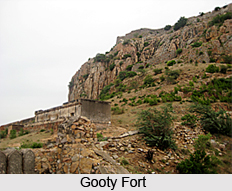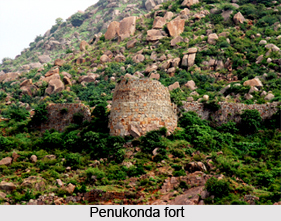 Historical Monuments in Anantpur district figure many in number. They date back many centuries, almost five hundred or more, and are found scattered along the entire district. The historical monuments of Anantpur district are among the top tourist attractions of the place. Some of the most prominent monuments are discussed below.
Historical Monuments in Anantpur district figure many in number. They date back many centuries, almost five hundred or more, and are found scattered along the entire district. The historical monuments of Anantpur district are among the top tourist attractions of the place. Some of the most prominent monuments are discussed below.
One of the tourist attractions of the Anantapur district is the Dharmavaram. There is historical evidence to prove that it was ruled by Vijayanagar Vidya kings for nearly 500 years. Dharmavaram is located at a distance of 46 km from Anantapur and 200 km from Bengaluru. This place is well connected by rail and road. Private transport facility is available from Anantapur.
Found at Dharmavaram is the Dharmavaram tank. It is one of the large tanks in Anantapur district. Sri Kriyasakhti Wadiyar, who constructed the tank, built a village in memory of his late mother Dharmamba and named it Dharmavaram.
Dharmavaram is famous for the temple of Sri Lakshmi Chennakesava Swamy. The temple is renowned for its architectural brilliance and for the perennial waterspout and pillars. The temple has a multi-storied tower, extensive enclosures and an entrance carved in the Vijayanagar style. The architecturally exquisite Ramalingeswara Temple has a perennial water spout and seven independent pillars which produce seven different musical notes when struck.
Dharmavaram is also known for its cotton and silk weaving industry. Dharmavaram silk sarees are well known all over the country. Leather puppets are also made in the vicinity. It is famous for silk sarees and has a great past. Thousands of families depend on the silk industry, for which Dharmavaram attained fame. There are more than a thousand shops in the town, which sell silk sarees. Nearly 30 silk cooperative societies help those engaged in the trade. This silk-ware is exported to Germany, France and other countries abroad. Only in Dharmavaram exists a Silk Exchange. Many freedom-fighters belong to this place.
Hemavanthi is a popular tourist spot due to its rich historical legacy. Hemavathi in Ananthapur district is situated at a distance of 37 km from Madakasiri and 148 km from Ananthapur. Hemavathi is well connected by road with frequent bus and private transport facilities from Madakasiri. The nearest railhead is at Hindupur.
Hemavathi was once capital of the Pallava dynasty during the 9th -10th centuries. It is a repository of a striking collection of Pallava and Chola art and architecture. Hemavathi assumed considerable importance between the 9th and 10th century AD, under the Nolamba Pallavas when it was known as Henjeri. Nolambas or Nodambas trace their descent from a mythical demon of that name. Trinayana Pallava or Mukkanti was regarded as the founder of this royal line. Nolamba rulers were known for their patronage for arts and religion. Hemavathi is famous for the temple of Doddeswara Swamy. A Nandi made of black basalt granite 8 feet in length and 4 feet in height, sits at the entrance. There is a 6 feet tall Lingam installed inside the sanctum sanctorum. Jain devotees from all over India converge annually on the Jain temple located in hemavati.
 Gooty is one of the oldest hill forts of Andhra Pradesh. Gooty is located at a distance of 52 km from Ananthapur on the Kurnool-Bengaluru trunk road. This place is well connected by rail and road from Anantapur.
Gooty is one of the oldest hill forts of Andhra Pradesh. Gooty is located at a distance of 52 km from Ananthapur on the Kurnool-Bengaluru trunk road. This place is well connected by rail and road from Anantapur.
Gooty fort is situated at a height of 300 metres above the plains in Gooty. It is one of the oldest hill forts in Andhra Pradesh. The fort was built by the emperors of the Vijayanagara Kingdom. The Marathas under Murari Rao conquered it. Then it was taken over by Hyder Ali in 1773 and eventually fell into the British hands after the defeat of Tipu Sultan in 1799.The fort was built in the shape of a shell and has 15 forts with 15 main doors (mukahdwarulu) inside the structure. There is a small pavilion made of polished lime stone called Murari Rao`s seat. This pavilion is on the edge of a cliff from where one can have a panoramic view of the surroundings. The unique feature of the fort is the availability of water resources at such a height.
The fort at Penukonda is a splendid structure and is a much visited tourist spot. Penukonda is 50 km from Anantapur and is located on the way to Bengaluru (on National Highway No. 7). It is well connected by road with frequent buses and private transportation from Anantapur.
Penukonda is mentioned as Ghangari in the local inscriptions. The structure of the fort shows the remarkable plan and strategic view of the medieval period. There are a good number of temples in the Fort. The Penukonda Fort, constructed with stone by mixing lime and clay, served as the capital of the Vijayanagar Empire for a short period and remained inaccessible to the enemies. Now, there are two important sights here. One is the "Gagan Mahal" which was used as a summer resort by the Vijayanagar Kings. The Gagan Mahal witnessed the majesty and aristocracy of the Royal times and was built in 1575 AD. The other is "Babayya Darga" which is the symbol of communal harmony between Hindus and Muslims.
Located about 35 kms from Kadiri and 100 kms from Anantapur is a famous banyan tree, called the "Thimmamma Marrimanu``. It is regarded as the biggest of its kind in South India. Its branches spread over nearly 5 acres. It is named after `Thimmamma` who was considered to be the representative of the Almighty. A small temple dedicated to Thimmamma lies under the tree. She is said to have married a Bala Veerayya who died in 1434, and Thimmamma committed `Sati`. The banyan tree is believed to have sprouted at the place where she ascended the funeral pyre. The people of this area strongly believe that if a childless couple worship "Thimmamma" they will have a child the very next year. A big `Jatra` is conducted here on the day of `Shivaratri` when thousands of people flock here to worship `Thimmamma` on this occasion.
Thus mentioned above are the various historical monuments of Anantpur district which form the major tourist attraction of the place.






